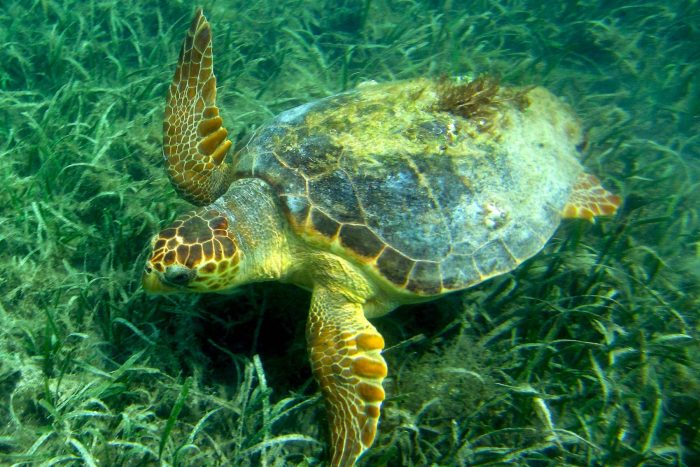Loggerhead Turtle
Caretta caretta
The loggerhead turtle is the largest hard-shelled sea turtle, with a heart-shaped, reddish brown shell. It can be found in the Chesapeake Bay from May to November.
This section shows one large critter image at a time. Use the thumbnails that follow to select a specific image to display here.

This gallery contains a grid of small thumbnails. Selecting a thumbnail will change the main image in the preceding section.
Appearance
The loggerhead turtle is a large sea turtle that can grow to be between 31 and 45 inches in length and weigh between 170 and 350 pounds. This makes them the largest hard-shelled sea turtle alive today. The carapace (top shell) is heart shaped while the plastron (lower shell) is smaller and hingeless.
Star-shaped, light and dark streaks may be present on the shell. The top of the head, neck, shell and front of the fore-flippers are reddish brown. The underside, sides of neck and parts of the flippers are cream to yellow. The loggerhead’s snout is short and the upper jaw is yellowish brown.
The fore-flippers are large while the hind-flippers are short and paddle-like. Each flipper has one or two claws. Juveniles have a brown carapace with three keels (or ridges) and a whitish, yellowish or tan plastron.
Feeding
Loggerhead turtles are mainly carnivores and feed on invertebrates. They crush them with their powerful jaws before swallowing. They forage for horseshoe crabs, but will also eat other crustaceans, sponges, jellyfish, mollusks, snails, fish, fish eggs and sea grasses.
Predators
Unlike most turtles, sea turtles cannot withdraw into their shells for protection. Loggerheads count on their hard shell and rough, scaly skin on their head and neck to protect them from predators. These defenses usually work, but they are still preyed upon by sharks or killed by humans when they get caught in fishing gear.
Hatchlings have far fewer defenses and many predators. Females try to disguise nests, but they still suffer from predation. Hatchlings emerge at night to try and avoid predators, but they are still eaten by raccoons, crabs, birds, foxes and carnivorous fish.
Reproduction and life cycle
Known for their migratory behavior, some loggerhead turtles have been recorded migrating up to 3,000 miles. Loggerheads in temperate waters migrate towards the equator to avoid cold winter waters.
The breeding season lasts from April to August. Loggerhead turtles tend to return to the same nesting area year after year. Adults may even return to the very beach where they were hatched. In the Chesapeake Bay region, this is usually a barrier island with a sand beach that’s high enough so nests are not destroyed by high tides or soaked by ground water rising from below.
A female may lay two to five nests per year, each with 110 to 130 eggs. Like many turtles, loggerheads have temperature-dependent sex determination. This means that the sex of the hatchlings is determined by egg temperature during incubation. There is no parental care. Females leave the eggs after they have been buried. Hatchlings emerge from the nest at night and head towards the ocean.
Not much is known about the lifespan of loggerhead turtles, but it is estimated that they can live for 30 to 62 years in the wild.
Did you know?
- Loggerhead turtles have salt glands near their eyes which let them drink salt water and excrete salt in high concentrations. Some people have observed nesting females “crying” for their young, but they are really excreting salt.
- A typical dive lasts for four or five minutes, but loggerheads are capable for diving for up to 20 minutes and can rest for hours without breathing.
- Loggerhead turtles are a keystone species. They feed on many invertebrates, affecting their populations and allowing their broken shells to be used as a source of nutrients for other species. Their eggs become food for predators, and over 100 species can live on the loggerhead’s shell.
- Like all sea turtles, loggerheads are in decline world-wide, the greatest cause of which is capture in fishing gear. However, along the North American coast, loggerheads are currently the most common sea turtle. Nevertheless, they are listed as threatened under the U.S. Endangered Species Act.
- Caretta is derived from the French “caret” which means “a kind of turtle.”
Sources and additional information
- Animal Diversity Web: Caretta caretta – University of Michigan Museum of Zoology
- Field Guide to Maryland’s Turtles (Order Testundines) – Maryland Department of Natural Resources
- Reptiles and Amphibians – Peterson Field Guides
- Reptiles and Amphibians of Virginia: Loggerhead Sea Turtle – Virginia Herpetological Society
- Wildlife Information: Loggerhead Sea Turtle – Virginia Department of Wildlife Resources
